Something Old...
I was able to spend some time this weekend in the garden. For the most part, this was routine maintenance, involving watering plants and pulling occasional weeds. But I also made a dent in the East bed, which was overrun with weeds. Fortunately, I was able to find my plants underneath. I also found lots of hoof marks from deer, so I expect they saw the lush weed growth as something tasty. My New England Asters (Symphyotrichum novae-angliae) got their tips munched some days ago, but have recovered quite well.
You can see from this picture just how high the weeds got. I'd cleared out the White Wild Indigo (Baptisia alba), which is the small plant behind the metal label. There are four more hiding in the jungle behind it. I can't see them, either.

I'm also revelling over my Prairie Clovers; I have four, two purple (Dalea purpurea) and two white (Dalea candida). They look amazing and are growing up very well this year; I planted them late last year, and thought they died over the winter. The colors of the blooms are wonderful. You can see both in this photo.
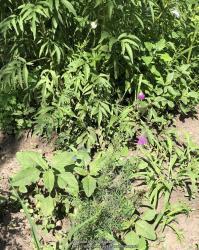
The Swamp Milkweed (Asclepias incarnata) is doing well, also. The existing one has been attracting insects; I even photographed a Monarch butterfly on it! I've seen one several times, but only one at a time, so I don't know if I'm seeing only one butterfly or several. But it is reassuring that at least one Monarch knows where it is.
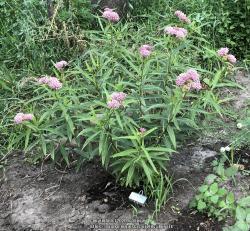
The first blooms on my Wild Bergamot (Monarda fistulosa) showed up this weekend. They have a delicate scent and a pale lavender color. I don't think I had any blooms last year, so this will be exciting, to see what insects are attracted to it.

For the Birds
One of the big maintenance activities this weekend was refilling the feeders. Remember, the whole point of me getting into gardening was to make it more appealing to birds. So, providing food for the birds is important. Take a look at this panorama:

Here's a key to what you are seeing in the photo, numbers corresponding to those in the photo, from left to right:
We Managed to Get Outside Today
We went outside before the weather got hot. High temperatures this weekend and this coming week are in the upper 80s°F. So we got some watering done, and some weeding. I was able to tear through some of a thatch of quackgrass to clear up some Black-Eyed Susans. But my wife, she was able to weed the herbs and grasses and some wildflowers:

I took that picture because I was getting tired out, and had to rest. You can see that recently-cleared earth is much easier to weed. My section was to the right of the orange bucket! Underneath the weeds, a couple inches deep, I came across two concrete pads. I'll wash them up and make some use of them. Though I have heard that my youngest daughter wants to make some concrete stepping stones with mosaic tiles in them, which would be nice.
Birds and Bugs
I saw the Ruby-Throated Hummingbird this morning. I always enjoy seeing it show up. I'd never noticed it before last year, when I put up the feeders, so it is nice to see this sparkly-green flying almond going around.
And now that the flowers are starting to bloom, there seem to be a lot more bees and other insects around. I even saw a Monarch Butterfly, but none of the milkweeds have any open flowers yet.
Milkweed Recovery!
Speaking of milkweeds, remember how I saw that my newer Swamp Milkweed got bitten off? I wasn't thinking, and should have made a cutting of the top. In any case, the stem now has a new leaf coming out, and it looks like a bud is coming from underground, too:
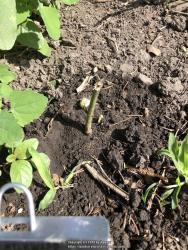
I don't begrudge animals trying to eat things, but I would like the plants to get further along and have a chance of survival! I'm glad this one is trying to make a comeback. I should put a wire cage around it, perhaps.
Mostly, I'm Watching
Part of my resting was due to some indications that I might have another health flare-up. Not fun, but they are random; it isn't the heat, or being active, or anything like that. And so I spent more time sitting and watching things, especially while I waited outside to see which way my health would go.
It was a very nice day. Still in the 70s°F this morning, with a variable wind, enough to cool you off, and a mostly-sunny sky. Lots of birds around. Just to give an example, these are the ones I saw, or heard, while I was outside:
The Best Laid Plans...
I had such high hopes. But this is a good lesson that, sometimes, you just have to enjoy looking at your garden instead of working in it.
First, let me show you how my original native wildflowers were getting choked with weeds. The Wild Bergamot, Monarda fistulosa, and Dwarf Joe-Pye Weed, Eutrochium dubium 'Phantom,' stand tall above most, but the weeds will catch up if they aren't taken out.
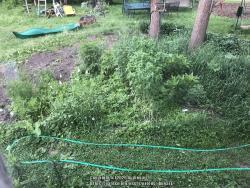
I wanted to clear all those weeds out, but I was also busy doing things like making dinners and such. Plus, there were a couple other factors: First, I finally exhausted all my mandatory vacation days from work; and second, I had two, separate health flare-ups that required me to rest, one right after the other. As a result, I only made this much progress:

It's hard to see, but I did clear out weeds in the left weeded area around one of the returning Butterfly Weed plants, Asclepias tuberosa. So I'm glad I got some progress, but I didn't get near as much as I wanted.
The lesson, as with anything in a garden, is that -- sometimes -- you just have to wait. In this case, I wasn't waiting for rain, or germination, or what have you; I waited for my health to recover so I could get outside and grub around. Honestly, it is only today that I feel close to that; and that's eleven or so days from when my health first tanked. During that time, I've mostly looked outside and enjoyed seeing birds. Everytime I see the Ruby-Throated Hummingbird, for instance, it cheers me up.
Something Lost
One thing I may have lost is my new Swamp Milkweed, Asclepias incarnata. I noticed that the stem had been not just bent, but broke, and I suspect some animal may have tried a taste.
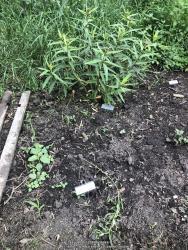
If I had been thinking, I would have tried to treat the top as a cutting and get it to root. The remaining stem is nice and green, so it might recover; sometimes, we get surprises like that. I'll let you know.
On the plus side, the original Swamp Milkweed from last year is doing quite well, as you can see, and has flower beds ready to erupt.
Something Regained
Remember how I had to prune my grapevine in order to install a new grape arbor? I mentioned that new shoots were coming back, but look at it:
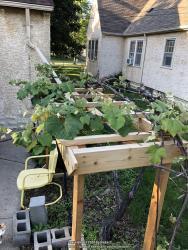
An Unexpected Guest
And lastly, I saw this fellow today, lounging in the water saucer for the Boston Fern, which moved outside when the low temperatures got high enough for it:
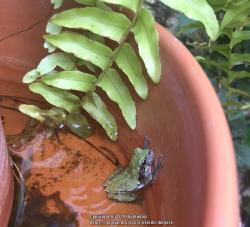
From what I can tell, this is a regular Minnesota amphibian called a Cope's Gray Treefrog. They actually range in color from brown, to green, to gray. The notable thing I found out is that it secretes a substance through its skin that will cause irritation on human skin, and especially mucosal membranes, so if you ever handle one like this, it likely means you should wash your hands.
What's Next?
WEEDING! I am behind, and that has to be my main goal for a while. When I do a good job, the bed is in pretty good shape.
As I mentioned before, after getting my new East bed planted, if I do nothing else this year but keep things weeded, it is a win. Especially for myself, my health can interrupt me anytime, so I have to be careful about attempting too much, and feeling bad about things half-done. Weeding, though, is perpetual; you can't feel bad about having to do more weeding, because you will always have to do more weeding!
Gardening is a Learning Process
I wanted to stress for anyone who gardens that you don't have to be perfect. Even if you are an expert, weather can surprise you, plants just might not grow -- or get eaten by animals! -- so nothing is certain. This means that it is just fine to forget things, or be unsure, or discover that you didn't know something. It is part of the process. It matters more that you take the opportunity to learn from your experience than if you did something perfect the first time through.
I Made a Mistake
My recent goof was putting plants in the ground without first adding soil amendments.
We've generally added compost before. We compost a lot of stuff, including kitchen scraps, so we almost always have some. But I didn't even put that in the holes I made.
Now, I've been adding it on top, and I even replanted some plants that needed a more mesic soil (mine is more clay/loam). And I've been doing better in things I've planted since.
Lessons Learned
I've been lucky because I'm planting native perennials, for the most part. The climate is just fine, and they are generally pretty tolerant of soil conditions. But I'm paying more attention to those soil conditions this year, because I want my plants to have the best chance at growing. So I've been paying attention to the following:
Soil Drainage
This shows in the Plant Database; for instance, if you compare Butterfly Weed, Asclepias tuberosa with another milkweed, Swamp Milkweed, Asclepias incarnata, you'll notice the following differences:


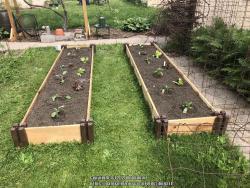

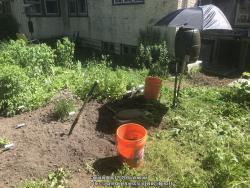
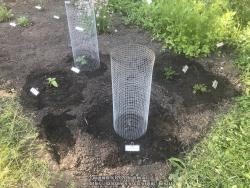
What Happened Since Last Time
Remember how I said I would add a section to give updates? Well, I kept adding and adding to the post I had on something else, that I realized I just needed a general update post. I'm amazed at what we have done in the last five days.
Raised Garden Beds
One of the more noteworthy things is that we decided to put together a couple of raised garden beds for vegetables.
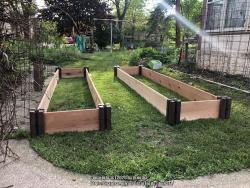
We bought 1x10 cedar planks, and used Master Mark raised bed starters we got at Menard's. You need two starter kits to do such a tall bed. It will take more than a cubic yard of garden soil to fill both beds.
We put them in the "courtyard," the section of yard between the back porch and the detached garage. It gets a lot of sun in the summer, and my wife prefers to have her tomato plants there; so it made sense to consider putting the rest of her vegetables there, as well.
Weeding
Actually had help from my college-aged son in weeding out part of my central bed. He said I couldn't trust him to know a weed from something I wanted to keep, so I marked off an area, pointed to two good-sized swamp milkweed plants, and said, "Remove everything but these." He did about half of it before lunchtime, filling a five-gallon bucket, which helped a lot:
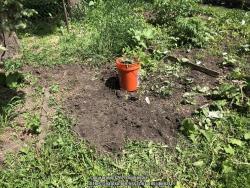
I was able to do more a couple days later, and continued into my grassland section:

I also got to work on weeding the Herb and Mercury 7 sections, and found that I did have a couple of Butterfly Weed plants that survived, after all. Here's one, you can see how much work still needs to be done (ignore the Fleabane on the left):

I think they might be from seed, but I need to rework the soil in that area, and reposition new plants, anyway. I'll be able to trade away some Cilantro and Black-Eyed Susans if anyone wants them! Contact me if you are in the Twin Cities area and are interested. Free to good home!
The Mulch Fairy Arrived!
We got our four-plus cubic yards of mulch delivered from Kern Landscape Resources. This is a picture after we'd been using it for a while:

The mulch was laid over some cardboard and cut-flat paper bags in the West bed, where acidic-soil-loving plants are put:

Right now, there are four Winterberry Hollies there, but a lot of weeds have been growing in the bare area that used to be under the huge Colorado Blue Spruce that once stood there. The idea of mulching it is to keep down the weeds, kill any grass, and see about planting things next year. We will see how this turns out! Here's the progress when we ran out of cardboard and newspaper:
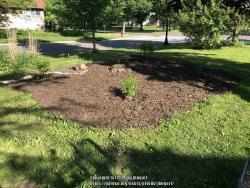
What's Next?
We need to get more cardboard or newspaper so we can finish mulching the West bed. This is kind of important, because then we can open the driveway to accept our raised-bed garden soil blend on Wednesday!
Next is the Mercury 7 section of the Central bed; this is where I planted my first perennials. It looks like the Large-Flowered Beardtongue didn't come back, so I may move the Butterfly Weed plants there.